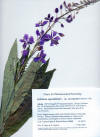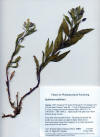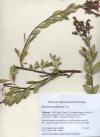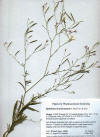|
Trees and
Shrubs of Kern County (Jan 2013)
Zauschneria californica C. Presl 1831 [Epilobium
canum (Zauschneria cana Greene 1887) Raven 1977]. Humming
bird fuchsia. Subshrub with shredding epidermis of stem-bark;
flowering Aug–Oct, flowers scarlet, long tubular, much like Fuchsia.
Rock walls of canyons, or open rocky slopes bordering streams,
below3,500 ft. Type from Monterey, CA. Kern Co.: Occasional from
the woody cismontane Upper Sonoran associations to the lower levels of
the yellow pine forest in the mountains and the Temblor Range, usually
growing around rocks (Twisselmann). CCH: Tillie Creek Campground near
Lake Isabella, Kern River Canyon, Grapevine Creek in the Tehachapi
Mts., and below turnoff to Valle Vista Campground in the Temblor Range,
457–610 m.
The
Jepson manuals have included Z. californica in Epilobium
(JM1: Wagner, Raven, Hock. JM2: Wagner & Hock), which its species seem
to consistently differ in the spreading of the petal lobes, and in the
flower color not scarlet but pale rose to white. Wagner, Hoch & Raven
(2007, Syst. Bot. Mongr. #83)), in their “Revised Classification of the
Onagraceae,” stated that “Section Zauschneria is extremely
distinctive by virtue of its long tubular orange-red zygomorphic
flowers, which are pollinated by hummingbirds; historically it has been
maintained as separate genus related to but quite distinct from
Epilobium,” followed by references to molecular studies that
reported 75–97% support for clades including section Zauschneria.
The
related Z. latifolia Greene 1887, with subspecies status
in JM2, is distinguished by the herbaceous habit and wider leaves (>6
mm); it is more common in the County, 884–2,072 m (CCH).
USDA ARS Record of Procurement for Antitumor Active
Species of Epilobium.
Epilobium angustifolium—Michigan Epilobium angustifolium—California
Epilobium glandulosum |









